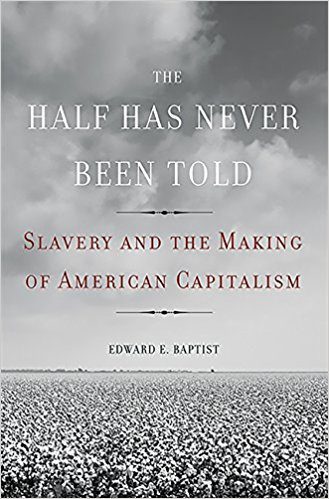 Edward Baptist, a history professor at Cornell University, is the author of a powerful book published a few years ago titled The Half Has Never Been Told: Slavery and the Making of American Capitalism. When I first heard buzz about this book, I only knew vaguely that it was about the U.S. Civil War. And my first thought was skeptical: how is it possible—with all that has been said, written, and filmed about the Civil War—that half the story has never been told. After reading the book, I am certainly willing to grant that Baptist has a point that important pieces of the story have at least been rarely told, intentionally ignored, and even censored.
Edward Baptist, a history professor at Cornell University, is the author of a powerful book published a few years ago titled The Half Has Never Been Told: Slavery and the Making of American Capitalism. When I first heard buzz about this book, I only knew vaguely that it was about the U.S. Civil War. And my first thought was skeptical: how is it possible—with all that has been said, written, and filmed about the Civil War—that half the story has never been told. After reading the book, I am certainly willing to grant that Baptist has a point that important pieces of the story have at least been rarely told, intentionally ignored, and even censored.
I was not surprised to learn that Baptist grew up in the South—specifically from North Carolina. I grew up in South Carolina, and I suspect that he too was raised hearing a particular spin on the Civil War as being fundamentally about states’ rights and individual liberty. But the more you learn about history, the more difficult it is to maintain any integrity around romanticized notions about the “Lost Cause” of the “Old South.”
If any doubt remains about the vital importance of this topic for today, yet more evidence was provided a few weeks ago. As I was about halfway through reading Baptist’s book, headlines began breaking in which—from my perspective—members of the Trump administration seemed to be unintentionally proving Baptist’s point for him. Their misstatements testified anew that we as a nation have rarely told our history well (or honestly), particularly regarding racial justice.
On Halloween, White House chief of staff John Kelly criticized the removal of Confederate moments as rooted in a “lack of appreciation of history and what history is.” He then ironically proceeded to demonstrate his own historical ignorance by saying that, “The lack of an ability to compromise led to the Civil War. And men and women of good faith on both sides made their stand where their conscience had to make their stand.” He dug the hole still deeper by calling Confederate General Robert E. Lee an “honorable man,” and saying, “It was always loyalty to state first back in those days.”
To say that, “the lack of an ability to compromise led to the Civil War” is either profoundly or willfully ignorant of the many horrific compromises that paved the road to the Civil War—not the least of which is the “Three-Fifths Compromise,” the deeply racist injustice inked into Article 1, Section 2, Paragraph 3 of the United States Constitution that help build our union on the compromise of counting enslaved human beings as “three fifths of all other Persons.”
No one is saying that Lee should be erased from the history books, but we need to be honest that he was not a national hero: General Lee was a white supremacist, a slave-owner, and after the war he refused to publicly denounce the Ku Klux Klan’s terrorist violence. We are more than a century-and-a-half past the point at which it should have been clear to all that Lee fought on the wrong side of history.
As someone who spent the first three decades of his life in the South, I can attest that the reason Lee is seen by some as a saint is a decades-long propaganda campaign to whitewash history. I will limit myself to only one among many examples. In 1935, the Virginia-born historian Douglas Freeman won the Nobel Prize for his four-volume biography about Lee. The trouble is that the book was to much of a hagiography, “a biography that idealizes its subject.” Our nation would be much better off if the Pulitzer Prize that year had been awarded to the African-American scholar and activist Dr. W.E.B. Du Bois for his landmark book Black Reconstruction in America:
Du Bois identified slavery as the fundamental cause of the war…and Reconstruction as a remarkable democratic experiment [that was tragically undermined by white supremacists].… Ignored at the time by mainstream scholars, today Du Bois’s insights are taken for granted by most historians, although they have not fully penetrated the national culture.
Relatedly, I urge you to read “W.E.B. Du Bois on Robert E. Lee” and “W.E.B. Du Bois on Confederate Monuments.” Almost a century ago, Du Bois was devastatingly insightful on both counts—that the war was fought to “perpetuate human slavery,” and the monuments are an attempt to whitewash history.
There are also many historical records from the Confederacy which testify that their explicit motivation was to perpetuate White Supremacy, but rather than lift up those voices, I will point to the words of President Abraham Lincoln, who though not perfect, in many ways represents aspects of the Republican Party at its best. In contrast to General Kelly’s false equivalency about “good faith on both sides,” Lincoln’s Second Inaugural Address said clearly that, “Both parties deprecated war, but one of them would make war rather than let the nation survive, and the other would accept war rather than let it perish, and the war came.”
Lincoln continued with an honest recounting of the war’s causes:
One-eighth of the whole population were colored slaves, not distributed generally over the Union, but localized in the southern part of it. These slaves constituted a peculiar and powerful interest. All knew that this interest was somehow the cause of the war. To strengthen, perpetuate, and extend this interest was the object for which the insurgents would rend the Union even by war….
Lincoln continues with a reference to “all the wealth piled by the bondsman’s two hundred and fifty years of unrequited toil,” which points to one of Baptist’s core messages in The Half Has Never Been Told (406).
Baptist debunks the myth that slavery was separate from the rest of the modern economy and that it was inevitably going to end as an allegedly obsolete model economically (xviii). The truth is that far from being a separate part of the economy, the profits from enslaved human beings picking cotton were a major factor in the crucial early decades following the American Revolution: “Between the 1790s and 1820, the United States acquired a near-monopoly on cotton, the world’s most widely traded commodity…. Cotton drove U.S. expansion, enabling our young country to grow from a narrow coastal belt into a vast, powerful nation with the fastest-growing economy in the world” (113).
And in sharp contrast to the myth in the North that slavery was inevitably going to end, the South fought precisely to protect the highly profitable business of exploiting human labor. The straightforward (though horrifying) truth is that under the threat and practice of torture, enslaved people picked “cotton faster and more efficiently than free people….” (xxi). “Many enslaved cotton pickers in the late 1850s peaked at well over 200 pounds per day. In the 1930s, after a half-century of massive scientific experimentation, all to make the cotton boll more pickable…cotton was often picked only 100 to 120 pounds per day (410).
When that half of the story is not told, you get the false mythology of the noble lost cause of the Civil War as being about states’ rights and individual liberty—instead of the tragic truth that the Civil War was fought to protect white supremacy and to perpetuate the highly profitably exploitation of enslaved human beings. When that half of the story was repressed, we were set-up to fail at Reconstruction in the decades following the Civil War (Foner 32)—causing the need for a Second Reconstruction during the Civil Rights movement and the need for a Third Reconstruction today to overcome what Michele Alexander has powerfully called the New Jim Crow, the insidious racial bias in our criminal justice system.
If we had collectively been honest about slavery and economics as the major causes of the Civil War, then perhaps we could have experienced “truth and reconciliation” during Reconstruction—which would have required reparations for enslaved human beings in payment for the huge profits that had been earned from their exploited labor. Indeed, after the Civil War, hundred of people who had been enslaved:
refused either to sign labor contracts or leave the plantations, insisting that the land belong to them. [In some cases], freed people not only claimed to be “joint heirs” to the estate but…abandoned the slave quarters and took up residence in the main house. (46)
The most famous promise made along these lines was a plan to give people who had been enslaved “forty acres and a mule.” Tragically, almost none of these opportunities came to pass. As I once heard the African American theologian James Cone say at a gathering of the American Academy of Religion, “Forty acres and a mule? At this point, I’d settle for an acre and a goat.”
We cannot change the past, but what will we do here in the present to help build a world of “peace, liberty, and justice” for all, not merely for some. In the words of a famous book by The Rev. Dr. Martin Luther King, Jr., Where Do We Go from Here? Chaos or Community? There are leaders in our country today, who are intent on cynically exploiting fear and resentment to sow seeds of chaos and division. But there is a different way: we can each do what we can within our spheres of influence to dismantle white supremacy—and, in the words of the activist Chris Crass, build up a multicultural “democracy with economic, gender, and racial justice for all…a world where the inherent worth and dignity of all people and the interconnection of life are at the heart of our cultures, institutions, and policies.”
What are some ways at getting better at telling the half that has rarely been told? If you have not been to the new African American Museum in D.C., I encourage you to visit it soon if you can, along with family and friends. If you haven’t read Ta-Nehisi Coates’s new book We Were Eight Years in Power, I encourage you to read it. (It was just named one of the top 100 books of the year by The New York Times.) The journey toward beloved community still beckons us toward a deeper, riskier love; a more honest, inclusive hope; a peace grounded in justice; and an uninhibited, childlike joy.
The Rev. Dr. Carl Gregg is a certified spiritual director, a D.Min. graduate of San Francisco Theological Seminary, and the minister of the Unitarian Universalist Congregation of Frederick, Maryland. Follow him on Facebook (facebook.com/carlgregg) and Twitter (@carlgregg).
Learn more about Unitarian Universalism: http://www.uua.org/beliefs/principles
















